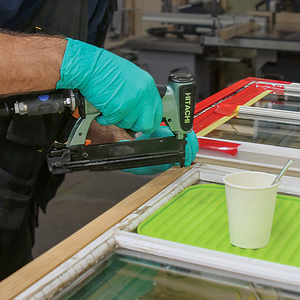Let’s just say I didn’t follow the manufacturer’s instructions.
Anderson 400 series, pine interiors with pine extension jambs. The part of the wood interior closest to the glass, on most of the windows, has a small section that is discolored from mildew or mold, owing to the occasional condensation from the glass dripping on the bare wood and leaving a stain.
I need to remove the mold and then somehow dry the wood enough to put a finish on the wood. I was thinking of using a basic water-based poly (no stain) because I want a natural finish and the damp wood should not hinder the ability of the poly to properly dry. Any suggestions about how to do this properly? I have bleach or TSP, I was thinking of wiping down the wood with a damp sponge and mild bleach solution, trying to dry it with a heat gun set on low, and putting the finish on immediately. It’s a miserable time of year to be doing this, because the windows seem to be condensing all the time. I also wonder if I would be better off just leaving them unfinished until warmer weather in spring, let them dry naturally, and finish them then. I should have put the finish on immediately after installation, but live and learn the hard way.



















Replies
It is probably mildew and not mold.
control the moisture fitst by finding out where it is coming from. If you are still in process of building and using an open flame heater, go to a furnace or electric heat. Maybe run fans or de-humidifier.
Then use sandpaper. I would not want to use bleach under a clear finish because it will discolour the wood
Welcome to the
Taunton University of Knowledge FHB Campus at Breaktime.
where ...
Excellence is its own reward!
I have not tried this yet but I was told it works,
Clean window frame with a mix of borax and tsp. Dry, then stain and seal.
Borax helps to keep mildew from forming again later.?!?
Maybe someone else will chime in if they have tried this.
Garett
As Piffin said, simply sand it off...carefully.
To dry the windows simply place a box fan close so it can blow on the glass. The air movement will keep the window much warmer than it would be normally and it will dry quickly.
Make sure the wood is dry or you may find yourself sanding off the discolored poly.
Also, the finish should go completely to the glass with no gaps, so essentially you're lapping onto the glass slightly.
Cheers.
Beer was created so carpenters wouldn't rule the world.
Jon, as stated already, find the source of your moisture, you're going to have to deal with it later if you don't deal with it now, 'cause it'll wreak havoc with the new finish, causing it to discolor and peel. Which is why I would say go with an oil based, not water based poly, more durable protection over the long haul. I would stay away from the heat gun, you could end up damaging the I.G. or disturbing the seal, especially if you are having colder weather, not worth that risk! Solve the moisture problem and let it dry naturally, then poly(oil based).
Geoff
P.S. use a good quality 2" china bristle sash brush, it'll make your job easier and look better too!
Sounds like you have too much moisture in the room in question - like others said, I'd find the source of excess moisture in the room/house first and get some dehumidifiers/air circulation going to keep the room dry...or the problem will just keep arising. You've probably heard it before, right, warm air holds more moisture, but when the warm moist air hits the window glass it cools and cannot hold the moisture anymore, etc., etc. I see it all the time in Japan when people heat their rooms with a kerosene heater with a kettle on top- all of the windows in the room have little puddles of water below them, and the people call me to come and fix the "leaky windows"....hmmm....???
Stay away from chemicals to take the mold off, I'd just dry the windows, sand the wood lightly, and then finish them once you're sure the windows are dry. I'm pretty sure they also sell mild/mildew killer for those applications. They turn the wood white again, and also prevent mold from re-appearing for quite a while.
Good luck..
SS
Well, part of the problem is that the house is a timber frame. Green timbers = lots of trapped moisture, warm house = release of moisture and condensation. The outside temperature today is about 10 degrees F. We've also been painting the entire house with latex paint, drying paint = evaporation of moisture. The dilemma appears to be that I can't actually control the moisture. I may have to wait until warmer weather to finish the windows and exterior doors.
Jon, if you have double hung windows, try dropping the upper sash about 1-2" for about 15-20 minutes, you'll be surprised how effective it can be in helping to control moisture in the house, do this every day you are painting, after your done for the day.
Geoff
sure you can control it. get de-humidifiers and fans
Welcome to the Taunton University of Knowledge FHB Campus at Breaktime. where ... Excellence is its own reward!
Yes to dehumidifiers, they work. Get 2 if needed, it's worth it.
If you sand, make sure you don't scratch the glass. Either be careful, or mask, 1 mm or so from the wood edge. Then you can work fast applying your finish, which will seal the glass-to-wood joint, then peel the tape and voila.
On 2nd thought and if IIRC, the new 400's come with a plastic film all over the glass, to be peeled after finishing.